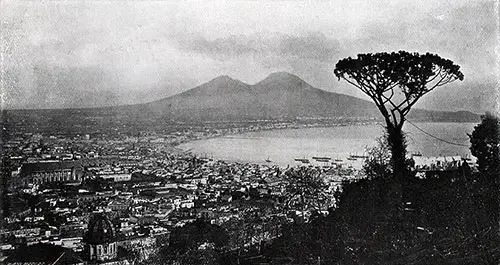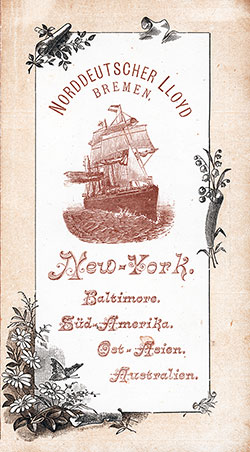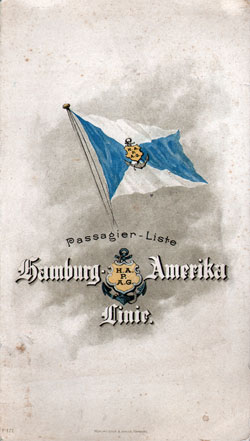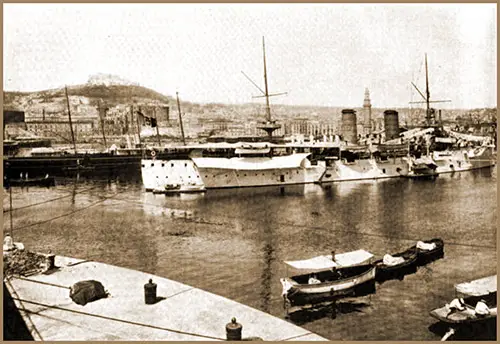Naples, Italy Passenger Lists 1894-1954

Naples, Italy Showing the Harbor circa 1906. | GGA Image ID # 1766ff04b6
Naples is the capital of Campania and the third-largest municipality in Italy. The port of Naples is one of the most important in Europe and has the world's second-highest passenger flow level, after the port of Hong Kong.
Naples Passenger Lists - 1890s

1894-12-14 SS Werra Passenger List
Steamship Line: Norddeutscher Lloyd (North German Lloyd)
Class of Passengers: Cabin
Date of Departure: 14 December 1894
Route: Naples to New York via Gibraltar
Commander: Captain G. Pohle
Naples Passenger Lists - 1900s

1900-12-18 SS Kaiser Wilhelm II Passenger List
Steamship Line: North German Lloyd / Norddeutscher Lloyd
Class of Passengers: Cabin Class
Date of Departure: 18 December 1900
Route: New York to Genoa via Gibraltar and Naples
Commander: Captain D. Hoegemann

1901-01-16 SS Aller Passenger List
Steamship Line: North German Lloyd / Norddeutscher Lloyd
Class of Passengers: Cabin
Date of Departure: 16 January 1901
Route: Genoa to New York via Naples and Gibraltar
Commander: Captain B. Wilhelmi

1902-01-26 SS Fürst Bismarck Passenger List
Steamship Line: Hamburg Amerika Linie / Hamburg American Line (HAPAG)
Class of Passengers: Cabin
Date of Departure: 26 January 1902
Route: Naples to New York via Gibraltar
Commander: Captain Heinrich H. Barends

1903-05-16 SS Vancouver Passenger List
Steamship Line: Dominion Line
Class of Passengers: Saloon
Date of Departure: 16 May 1903
Route: Naples to Azores and Boston
Commander: Captain MacDonald

1905-08-19 RMS Pannonia Passenger List
Steamship Line: Cunard Line
Class of Passengers: Saloon
Date of Departure: 19 August 1905
Route: Trieste to New York via Fiume, Palermo, and Naples
Commander: Captain E. Pentecost

1906-08-21 SS Moltke Passenger List
Steamship Line: Hamburg Amerika Linie / Hamburg American Line (HAPAG)
Class of Passengers: First Class
Date of Departure: 21 August 1906
Route: Genoa to New York via Naples
Commander: Captain Reessing

1907-01-19 SS Celtic Passenger List
Steamship Line: White Star Line
Class of Passengers: First Class
Date of Departure: 19 January 1907
Route: New York to Alexandria via the Azores, Madeira, Gibraltar, Genoa, and Naples
Commander: Captain J. B. Ranson, LT R.N.R.

1908-08-26 RMS Cretic Passenger List
Steamship Line: White Star Line
Class of Passengers: First Class
Date of Departure: 26 August 1908
Route: Genoa to New York via Naples and Azores
Commander: Captain J. B. Kelk

1908-10-04 RMS Romanic Passenger List
Steamship Line: White Star Line
Class of Passengers: First Class
Date of Departure: 4 October 1908
Route: Genoa to Boston via Naples, Almeria, and Azores
Commander: Captain R. Lobez

1908-11-12 SS Prinzess Irene Passenger List
Steamship Line: Norddeutscher Lloyd (North German Lloyd)
Class of Passengers: First Class
Date of Departure: 12 November 1908
Route: Genoa to New York via Naples and Gibraltar
Commander: Captain F. von Letten-Peterssen
Naples Passenger Lists - 1910s

1910-05-19 SS Friedrich Der Grosse Passenger List
Steamship Line: Norddeutscher Lloyd (North German Lloyd)
Class of Passengers: Cabin
Date of Departure: 19 May 1910
Route: Genoa to New York via Naples, Palermo, and Gibraltar
Commander: Captain R. Dahl

1911-07-23 SS Canopic Passenger List
Steamship Line: White Star Line
Class of Passengers: First Class
Date of Departure: 23 July 1911
Route: Genoa and Naples to Boston via the Azores
Commander: Captain J. O. Carter

1912-01-20 SS Berlin Passenger List
Steamship Line: North German Lloyd / Norddeutscher Lloyd
Class of Passengers: First and Second Cabin
Date of Departure: 20 January 1912
Route: New York to Genoa via Gibraltar, Algiers, and Naples
Commander: Captain A. Harrassowitz

1912-08-21 RMS Saxonia Passenger List
Steamship Line: Cunard Line
Class of Passengers: Saloon
Date of Departure: 21 August 1912
Route: Trieste to New York via Fiume, Patras, Naples, and Gibraltar
Commander: Captain D. S. Miller (CDR R.N.R.).

1913-06-17 TSS Sant Anna Passenger List
Steamship Line: Fabre Line
Class of Passengers: Cabin
Date of Departure: 17 June 1913
Route: New York to the Mediterranean via Naples and Marseilles
Commander: Captain François Pavy

1913-11-04 SS Carpathia Passenger List
Steamship Line: Cunard Line
Class of Passengers: Saloon
Date of Departure: 4 November 1913
Route: Fiume to New York via Trieste, Patras, Messina, Naples, Almeria, and Gibraltar
Commander: Captain William Prothero

1913-11-22 RMS Cretic Passenger List
Steamship Line: White Star Line
Class of Passengers: First Class
Date of Departure: 22 November 1913
Route: Genoa to Boston via Naples and Azures
Commander: Captain F. B. Howarth

1914-01-08 SS Berlin Passenger List
Steamship Line: North German Lloyd / Norddeutscher Lloyd
Class of Passengers: First and Second Cabin
Date of Departure: 8 January 1914
Route: Genoa to New York via Naples, Palermo and Gibraltar
Commander: Captain A. Harrassowitz

1914-04-16 TSS Canada Passenger List
Steamship Line: Fabre Line
Class of Passengers: First Class
Date of Departure: 16 April 1914
Route: Special Winter Voyage from New York to the Mediterranean calling at Algiers, Naples, Villefranche and Marseilles
Commander: Captain Victor Bouleuc
Naples Passenger Lists - 1920s

1926-01-30 SS Transylvania Passenger List
Steamship Line: Anchor Steamship Line
Class of Passengers: Cruise
Date of Departure: 30 January 1926
Route: New York to Funchal (Madeira); Lisbon; Cadiz, Spain; Gibraltar; Algiers; Tunis, Carthage; Phaleron Bay (Athens); Constantinople; Haifa; Alexandria; Naples; Villefranche (Nice); Monte Carlo; Cherbourg; and return to New York.
Commander: Captain D. W. Bone

1926-04-10 SS Colombo Passenger List
Steamship Line: Navigazione Generale Italiana (NGI)
Class of Passengers: Cabin
Date of Departure: 10 April 1926
Route: New York for Palermo, Naples and Genoa
Commander: Captain Arturo Romano

1926-08-19 SS California Passenger List
Steamship Line: Anchor Steamship Line
Class of Passengers: Tourist Third Cabin
Date of Departure: 19 August 1926
Route: Naples to New York via Gibraltar
Commander: Captain Alex. Collie

1927-03-16 SS Colombo Passenger List
Steamship Line: Navigazione Generale Italiana (NGI)
Class of Passengers: One
Date of Departure: 16 March 1927
Route: Genoa to New York via Naples and Palermo
Commander: Captain Filippo D' Esposito

1927-06-30 SS Conte Biancamano Passenger List
Steamship Line: Lloyd Sabaudo
Class of Passengers: First Cabin
Date of Departure: 30 June 1927
Route: New York to Genoa via Gibraltar and Naples
Commander: Captain Giuseppe Turchi

1927-09-07 SS Colombo Passenger List
Steamship Line: Navigazione Generale Italiana (NGI)
Class of Passengers: One Class
Date of Departure: 7 September 1927
Route: Genoa to New York via Naples
Commander: Captain Cav. Uff. Francesco Re.

1928-02-11 SS Patria Passenger List
Steamship Line: Fabre Line
Class of Passengers: First Class
Date of Departure: 11 February 1928
Route: Marseilles to New York via Naples and Palerme
Commander: Captain Juste Tempesti

1929-02-08 SS Adriatic Passenger List
Steamship Line: White Star Line
Class of Passengers: First Class and Tourist Third Cabin
Date of Departure: 8 February 1929
Route: Alexandria to New York via Syracuse, Naples, Monaco, and Gibraltar
Commander: Captain V. W. Hickson (Lt. Cmdr., R.N.R., Retd.)

1929-07-02 SS Providence Passenger List
Steamship Line: Fabre Line
Class of Passengers: First and Second Class
Date of Departure: 2 July 1929
Route: New York to Marseilles via Boston, Ponta Delgada, Lisbon, Naples, Palermo, Piraeus, Beirut, and Malta
Commander: Captain Laurent Vidal

1929-08-25 SS Saturnia Passenger List
Steamship Line: Cosulich Line - Trieste
Class of Passengers: First Class
Date of Departure: 25 August 1929
Route: Trieste to New York via Patrasso and Naples
Commander: Captain Stuparich Cav Roberto
Naples Passenger Lists - 1930s

1930-02-27 SS Laurentic Passenger List
Steamship Line: White Star Line
Class of Passengers: Tourist Third Cabin
Date of Departure: 27 February 1930
Route: Mediterranean Cruise from New York to Madeira, Gibraltar, Algiers, Monaco, Naples, Athens, Constantinople, Haifa, Alexandria, Syracuse, Naples, Monaco, Gibraltar, Cherbourg, and Southampton.
Commander: Captain E. L. Trant, R.D. (Cmdr. R.N.R., Retd.)

1930-08-19 SS Vulcania Passenger List
Steamship Line: Cosulich Line - Trieste
Class of Passengers: Tourist Third Class
Date of Departure: 19 August 1930
Route: Naples to New York via Cannes
Commander: Captain Antonio Hreglich

1931-01-10 SS France Passenger List
Steamship Line: Compagnie Générale Transatlantique / French Line (CGT)
Class of Passengers: First and Tourist
Date of Departure: 10 January 1931
Route: New York to Marseilles via Vigo, Casablanca, Rabat, Gibraltar, Naples, Capri, Monaco, and return via Le Havre or directly to New York
Commander: Captain G. Burosse

1932-06-28 SS Exeter Passenger List
Steamship Line: American Export Lines
Class of Passengers: One
Date of Departure: 28 June 1932
Route: New York to Alexandria via Gibraltar, Marseilles, Jaffa, Haifa, Beirut, and Naples
Commander: Captain C.C. Decker

1935-08-21 SS Rex Passenger List
Steamship Line: Italia Line
Class of Passengers: Special
Date of Departure: 21 August 1935
Route: Naples to New York via Genoa, Villefranche (Nice) and Gibraltar
Commander: Captain Grand' Uff. Francesco Tarabotto

1935-09-13 SS Rex Passenger List
Steamship Line: Italia Line
Class of Passengers: Special
Date of Departure: 13 September 1935
Route: Naples for New York via Genoa, Villefranche (Nice) and Gibraltar
Commander: Captain Francesco Tarabotto

1937-03-06 SS Conte Di Savoia Passenger List
Steamship Line: Italian Line
Class of Passengers: First Class
Date of Departure: 6 March 1937
Route: New York to Gibraltar, Naples, Villefranche, and Genoa
Commander: Captain Antonio Lena

1937-05-22 SS Roma Passenger List
Steamship Line: Italia Line
Class of Passengers: Tourist
Date of Departure: 22 May 1937
Route: New York to Madeira, Casablanca, Gibraltar, Algiers, Naples, and Genoa
Commander: Captain Attilio Frugone
Note: Annotated by the original owner (passenger)

1937-06-12 SS Roma Passenger List
Steamship Line: Italia Line
Class of Passengers: First Class
Date of Departure: 12 June 1937
Route: Genoa and Villefranche to New York via Naples and Gibraltar
Commander: Alberto Ottino
Note: Includes Color Map with preprinted Transatlantic Route

1938-07-13 SS Rex Passenger List
Steamship Line: Italia Line
Class of Passengers: Tourist
Date of Departure: 13 July 1938
Route: Genoa to New York via Cannes, Naples, and Gibraltar
Commander: Captain Attilio Frugone

1938-07-14 SS Vulcania Passenger List
Steamship Line: Italia Line
Class of Passengers: First Class
Date of Departure: 14 July 1938
Route: Trieste to New York via Dubrovnik, Patra, Naples, Palermo, Algiers, Gibraltar, Lisbon, and Azores
Commander: Captain William Lazzari

1938-08-09 SS Rex Passenger List
Steamship Line: Italia Line
Class of Passengers: Tourist
Date of Departure: 9 August 1938
Route: Naples to New York via Genoa, Cannes, and Gibraltar
Commander: Captain Giorgio Cavallini

1939-10-06 SS Rex Passenger List
Steamship Line: Italia Line
Class of Passengers: Tourist
Date of Departure: 6 October 1939
Route: Genoa to New York via Naples
Commander: Captain Attilio Frugone
Naples Passenger Lists - 1940s

1949-07-22 SS Saturnia Passenger List
Steamship Line: Italia Line
Class of Passengers: First Class
Date of Departure: 22 July 1949
Route: Genoa to New York via Naples, Gibraltar, and Azores
Commander: Captain Gianni Gladioli
Naples Passenger Lists - 1950s

1950-05-26 SS Conte Biancamano Passenger List
Steamship Line: Italia – Società di Navigazione
Class of Passengers: First Class
Date of Departure: 26 May 1950
Route: New York to Genoa via Lisbon, Gibraltar, and Naples
Commander: Captain Luigi Gulinelli

1950-07-04 SS Saturnia Passenger List
Steamship Line: Italia Line
Class of Passengers: First Class
Date of Departure: 4 July 1950
Route: Genoa to New York via Cannes, Naples, and Gibraltar
Commander: Captain Arrigo G. Gladulich

1950-08-11 SS Conte Biancamano Passenger List
Steamship Line: Italia Line
Class of Passengers: Cabin
Date of Departure: 11 August 1950
Route: Genoa to New York via Naples, Gibraltar, and Lisbon
Commander: Captain Pasquale Pezzuto

1950-09-14 SS Conte Biancamano Passenger List
Steamship Line: Italia Line
Class of Passengers: Cabin
Date of Departure: 14 September 1950
Route: Genoa to New York via Nables, Gibraltar and Lisbon
Commander: Captain Pasquale Pezzuto

1951-05-25 SS Vulcania Passenger Lists
Steamship Line: Italia Line
Class of Passengers: First Class
Date of Departure: 25 May 1951
Route: Genoa to Halifax and New York via Cannes, Naples, Palermo, and Gibraltar
Commander: Captain Giovanni Giurini

1951-08-12 SS Conte Biancamano Passenger List
Steamship Line: Italia Soc. An. Di Navigazione
Class of Passengers: Cabin
Date of Departure: 12 August 1951
Route: Genoa to Halifax and New York via Naples and Gibraltar
Commander: Captain Pasquale Pezzuto

1951-09-10 SS Constitution Passenger List
Steamship Line: American Export Lines (AEL)
Class of Passengers: Cabin Class
Date of Departure: 10 September 1951
Route: Genoa to New York via Cannes, Naples, and Gibraltar
Commander: Captain Bernt A. Jacobsen

1952-03-01 SS Constitution Passenger List
Steamship Line: American Export Lines
Class of Passengers: First Class
Date of Departure: 1 March 1952
Route: Naples to New York via Genoa, Cannes, and Gibraltar
Commander: Captain Bernt A. Jacobsen

1952-03-11 SS Saturnia Passenger List
Steamship Line: Italia Soc. An. Di Navigazione
Class of Passengers: Cabin Class
Date of Departure: 11 March 1952
Route: New York to Naples via Gibraltar, Barcelona, and Genoa
Commander: Commanded by Captain Piero Calamai.

1952-10-27 SS Independence Passenger List
Steamship Line: American Export Lines
Class of Passengers: Cabin
Date of Departure: 27 October 1952
Route: Naples to New York via Genoa, Cannes, and Gibraltar
Commander: Captain Hugh L. Switzer

1953-08-02 SS Independence Passenger List
Steamship Line: American Export Lines
Class of Passengers: Cabin
Date of Departure: 2 August 1953
Route: Naples to New York via Genoa, Cannes, and Gibraltar
Commander: Captain Ernest H. Nelson

1953-08-21 SS Constitution Passenger List
Class of Passengers: First Class
Date of Departure: 21 August 1953
Route: New York to Naples via Gibraltar, Cannes, and Genoa
Commander: Captain Ernest H. Nelson

1953-08-24 SS Independence Passenger List
Steamship Line: American Export Lines
Class of Passengers: First Class
Date of Departure: 24 August 1953
Route: Naples to New York via Genoa, Cannes and Gibraltar,
Commander: Captain Hugh L. Switzer

1954-07-03 SS Independence Passenger List
Steamship Line: American Export Lines
Class of Passengers: Tourist
Date of Departure: 3 July 1954
Route: Naples to New York via Genoa, Cannes, and Gibraltar
Commander: Captain Hugh L. Switzer

1954-08-14 SS Independence Passenger List
Steamship Line: American Export Lines
Class of Passengers: Cabin
Date of Departure: 14 August 1954
Route: Naples to New York via Genoa, Cannes, and Gibraltar
Commander: Captain Ernest H. Nelson

1954-11-05 SS Constitution Passenger List
Steamship Line: American Export Lines
Class of Passengers: First Class
Date of Departure: 5 November 1954
Route: New York to Naples via Cannes and Genoa
Commander: Captain Bernt A. Jacobsen

1954-11-09 SS Independence Passenger List
Steamship Line: American Export Lines
Class of Passengers: Cabin
Date of Departure: 9 November 1954
Route: Naples to New York via Genoa, Cannes, and Gibraltar
Commander: Captain Hugh L. Switzer

1954-12-07 SS Constitution Passenger List
Steamship Line: American Export Lines
Class of Passengers: First Class
Date of Departure: 7 December 1954
Route: Naples to New York via Genoa, Cannes, and Gibraltar
Commander: Captain Bernt A. Jacobsen

The Port of Naples, Italy. Supplement to The Standard, 18 December 1912. | GGA Image ID # 1d427612ff
During the early 20th century, efforts to industrialize the city were likewise hampered by administrative corruption and a lack of infrastructure. Facing a slumping economy, many poorer Neapolitans emigrated northwards or headed overseas to the United States and Argentina.
Naples and Genoa have all the natural advantages required for navigation by the largest vessels. Still, at each, the volume of trade has mostly outgrown facilities for handling goods.
Furthermore, this is true as regards merchandise for transportation by both the railroad and ocean lines. There are few piers at Naples at which vessels may discharge and load cargo, warehouses for safe storage are inadequate in number and limited in capacity, mechanical agencies for handling cargo are insufficient, and the manual force employed is not entirely efficient.
These deficiencies are augmented because Naples is simply a port of call, vessels touching there remaining, as a rule, no longer than twenty-four hours to discharge or take on passengers and cargo.
On the westward voyage, exigencies frequently arise, which shorten the stay at Naples. In such cases, vessels proceed to Genoa with cargo that the steamship lines could not discharge at the former port.
Emigrantion Through the Port of Naples (1911)
Naples has led all European ports in the number of emigrants embarking on the United States in recent years. At the time of the committee's visit, 12 steamship companies, including the White Star and North German Lloyd. Navigazione Generale Italiana. La Veloce, Fabre, Lloyd-Italiano, Hamburg-American, Anchor, Lloyd-Sabaudo, Spanish, Sicula-Americano, and the Prince lines carried immigrants from this port.
The above lines are mentioned in the order of their importance as emigrant carriers at the time under consideration. Emigrants arriving in Naples are quartered in boarding houses, which are under the supervision of the Government.
Sanitary officers and emigration officials frequently examine them. Steamship companies are required to board emigrants for one day before sailing. If a departure is delayed, they must maintain them until the ship sails and pay each 2 lire (40 cents) a day as damages for his detention.
The medical examination of emigrants at Naples takes place in the Capitaneria, a large building on the waterfront, just before the sailing of the ship. Emigrants pass in line before two United States Public Health and Marine-Hospital Service surgeons, one of whom examines for trachoma and the other for favus and other defects.
The inspection is made in the presence of the Italian emigration commission, representatives of the police department, and detail of carabinieri reali, or military police. Usually, there also present the ship's doctor, a doctor of the port, the Italian naval surgeon, who represents the Government on all ships taking emigrants from Italian ports, and an inspector of emigration.
Persons rejected by the United States medical officers are immediately removed from the enclosure. Persons not rejected pass before a police officer, who examines their passports. If this is satisfactory, the emigrant then goes aboard a lighter and is carried to the ship.
At the vessel's gangway, emigrants are met by police officers and a representative of the United States medical officials, who sees that inspection cards are appropriately stamped. Baggage labeled to indicate that it has passed the sanitary inspectors. Knives are also taken from the emigrants at this time by the police.
If everything is satisfactory, the seal of the United States Public Health and Marine-Hospital Service is stamped on the inspection card. After passing the first group of inspectors, emigrants are again examined for trachoma and favus by the ship's doctor.
This supplementary medical visit on this ship was inaugurated at the request of the United States medical officer in charge to prevent substitution, which, previously, had been quite common.
The United States officers at Naples take no part in examining second-class passengers, except that occasionally their advice is sought concerning questionable cases. A physician examines the second-class passengers employed expressly by the steamship companies, in conjunction with and under the supervision of the Italian emigration commission.
In addition to the medical examination, the United States Public Health and Marine-Hospital surgeon in charge at Naples has complete control of the inspection and disinfection of emigrant baggage. This is done in a well-equipped plant near the emigrant station.
At the time of the committee's visit, The Port of Naples employed one inspector and seven assistant inspectors. These men were under the control of the Marine-Hospital surgeon, acting officially as a quarantine officer, and the steamship companies bore the expense.
Emigrants are required to be vaccinated before embarking at Naples. This was done in a station near the place of embarkation at the expense of the steamship companies but under the supervision of the United States medical officers.
American consular officers have no part in examining emigrants at Naples, the usual consular function being delegated to the Marine-Hospital officer in charge. The consul, however, signs the bill of health in conjunction with the medical officer.
"Naples," in Emigration Condition in Europe, Reports of the United States Immigration Commission, Washington, Government Printing Office, 1911, p. 115-117.
⚠️ About Accuracy in Historical Records Research Tip
Context. The GG Archives presents passenger lists as faithfully as possible to the original documents. While OCR is generally accurate, portions of these collections—especially image captions and some transcriptions—are typed by hand and may include typographical or spelling variations. The original manifests themselves also contained clerical inconsistencies (names recorded phonetically, mid-voyage corrections, etc.).
What this means for your research:
- Search variant spellings of names (e.g., “Schmidt/Schmitt/Smith,” “Giuseppe/Joseph”).
- Cross-reference with immigration cards, passport applications, naturalization files, city directories, and newspapers.
- Treat manifests as primary sources with historical quirks—use them alongside corroborating records.
- For place names, consider historical borders and language variants (e.g., Danzig/Gdańsk, Trieste/Trst).
How to cite. When quoting a name from a manifest, consider adding [sic] for obvious misspellings and include a note such as “spelling as printed in original passenger list.”
Need help? If you spot a likely transcription error in captions, feel free to contact us with the page URL and a brief note—we love community input. 🙏
Curator’s Note
For over 25 years, I've been dedicated to a unique mission: tracking down, curating, preserving, scanning, and transcribing historical materials. These materials, carefully researched, organized, and enriched with context, live on here at the GG Archives. Each passenger list isn't just posted — it's a testament to our commitment to helping you see the people and stories behind the names.
It hasn't always been easy. In the early years, I wasn't sure the site would survive, and I often paid the hosting bills out of my own pocket. But I never built this site for the money — I built it because I love history and believe it's worth preserving. It's a labor of love that I've dedicated myself to, and I'm committed to keeping it going.
If you've found something here that helped your research, sparked a family story, or just made you smile, I'd love to hear about it. Your experiences and stories are the real reward for me. And if you'd like to help keep this labor of love going, there's a "Contribute to the Website" link tucked away on our About page.
📜 History is worth keeping. Thanks for visiting and keeping it alive with me.
